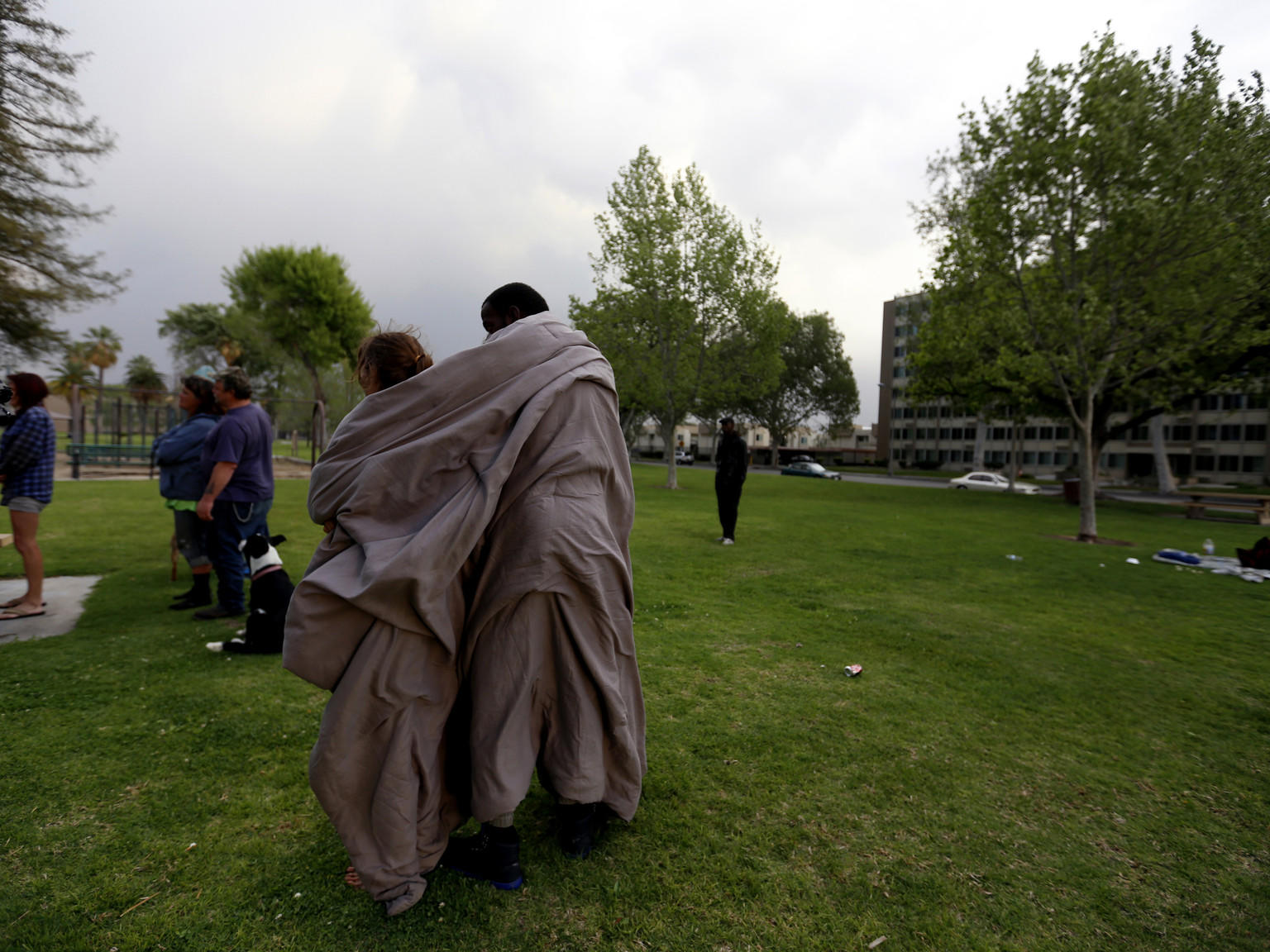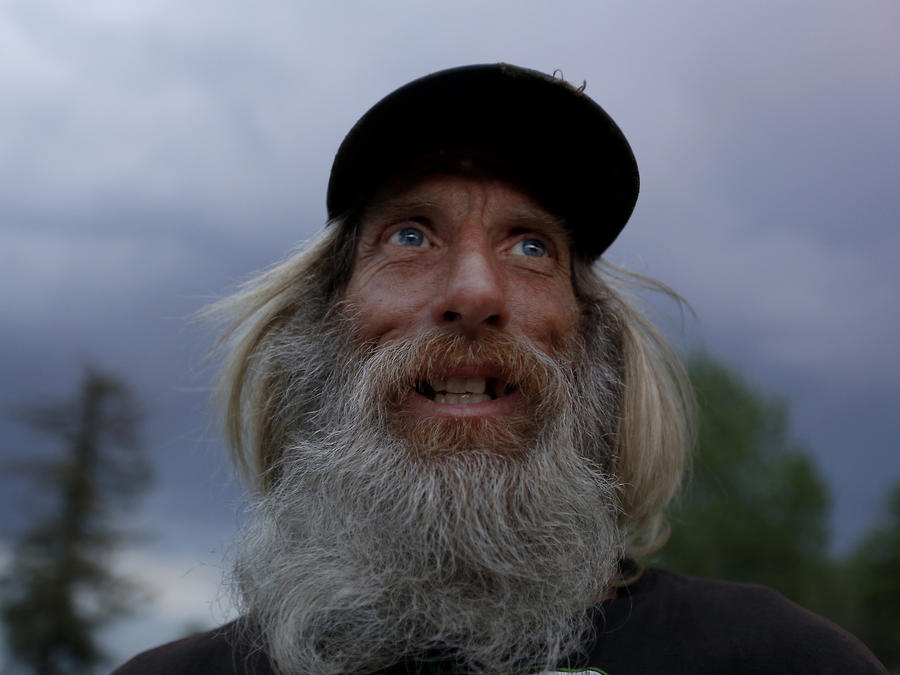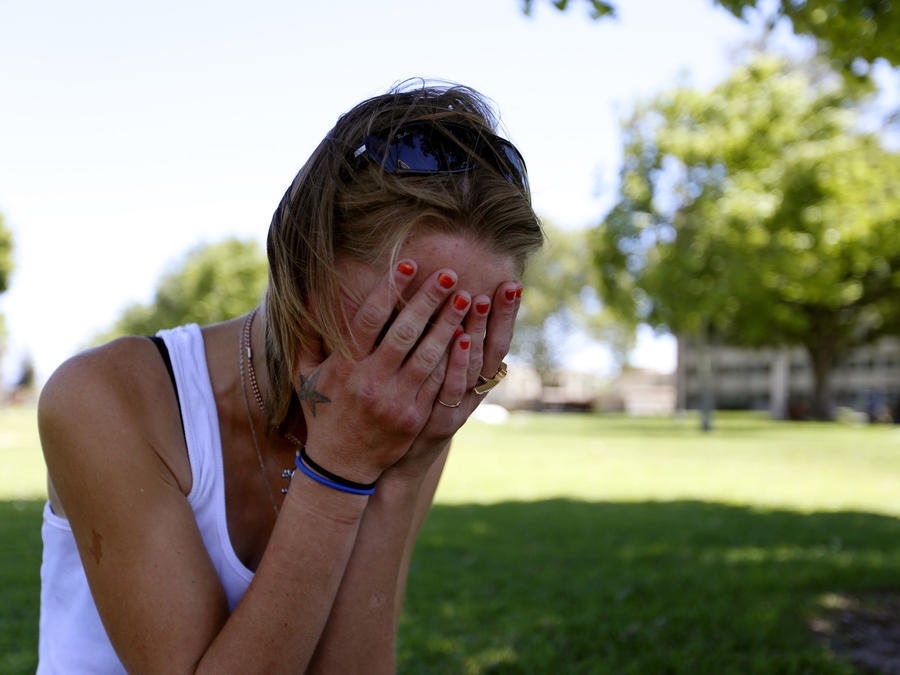The police had stopped rousting people, so Rick Burns hauled his gear down to the best spot on the creek.
He set up his tent and tarps on a man-made island under two fan palms next to a deep pool of spring water pouring over a small stone dam.
The waterfall and the breeze through the canebrakes give the space the ambience of a Japanese garden. And now the cane is getting high enough that judges in San Bernardino’s new 11-story courthouse won’t get annoyed at the sight of him and call the police to run him out.
Burns, 60, sleeps to the sound of gurgling water and croaking frogs. A 20-year-old woman from La Puente recently joined him.
He enjoys the companionship.
But the park’s comforts become oppressive when euphoria fades and memories fill sleepless days and nights.
Methamphetamine simmered for decades among bikers and truckers, then boiled over in California in the 1980s. Nowhere got seared worse than San Bernardino, a city 60 miles east of Los Angeles.
And unlike the crack epidemic in urban areas, the crank epidemic never waned.
The brown meth from desert labs was replaced by the white shards of crystal meth from Mexican super-labs.
A pound of good meth in the late 1990s cost $6,000 to $7,000, according to Sgt. Gary Schuelke, head of the San Bernardino police narcotics team. Now it costs half that.
People sleeping in Meadowbrook or in San Bernardino’s weedy lots, abandoned homes and cheap motels head out in the morning to steal and collect metal to recycle, and in a couple hours have the $10 for a dime bag and a good day’s high.
The drug’s low price and its high’s long duration make a pernicious combination in California’s poorest city of its size.
“Methamphetamine is everywhere,” Schuelke says.

Burns scrubs his clothes on the dam with a Zote bar of Mexican soap. A neon red dragon fly bobs, and sunflowers are starting to pop. He is solid and tan with a gray goatee and “Redlands” tattooed on his back.
He was once a tough guy, a meth cook in the desert willing to use muscle when needed until Mexican traffickers and an arrest for manufacturing put him out of business in 2003.
Now people in the park look to him as a voice of reason.


The 20-year-old woman floats in the warm water in her T-shirt and underwear. She doesn’t speak other than to answer simple questions. She says the name “Sophia” tattooed on her back is her daughter’s.
Burns finishes wringing his clothes and sits in the water.
“It doesn’t get much better than this,” he says. Mosquito fish nibble the dead skin flakes on his back.
His best friend Phil Eby stops by with his Chihuahua mix.
Eby, 50, is wiry and sociable, an Army veteran who jumped to help when churches came to distribute food. He is always on the move. When he lived in Fontana, they called him the jack rabbit for his ability to escape the law.
“Chinese lady is here!” he yells.
A Vietnamese woman who brought lunch to the homeless opens the trunk of her car.
Eby strides up the creek to alert others.
“You seen Jeff?” he asks Burns.
Jeff is an important figure in the park. He transformed much of the creek by way of a meth-fueled industriousness, night after night carving wide trails, digging out ponds and building dams and trellis-fences for the grape vines.
Stolen solar landscaping lights mark the path to his “new Shangri La” hidden in the mulberry trees downstream.
Burns hasn’t seen Jeff, and Eby continues up the creek.
He calls to people living in a clump of wild grapevines.
He yells into an old drainage tunnel under 3rd Street, originally built by Mormon pioneers.
“Brent! Food!”

Brent is gracious but shy and doesn’t come out for days at a time. No one dares to slog through the algae in the total darkness to see how far up the pipe he resides.
Eby and Burns eat their Vietnamese wraps by the pond, then invite a couple of friends to go under the tarps for a smoke. Burns takes a few shards of meth and puts them into the glass bulb of an oil burner pipe. He heats it up with a small torch until it liquefies and white smoke fumes up.
Burns takes a hit.
They pass it around and joke about the power meth brings to their libidos. Outside, the nymph from La Puente does a slow ballet in the pond.
Under a bridge farther downstream, Amy Walls paces manically as traffic on 2nd Street groans overhead. She and her boyfriend, Josh, have just shotgunned a nickel bag of methamphetamine — inhaling it, then blowing it into the other’s mouths to get the most of the drug.
Dried blood crusts the rim of her nostril. Cuts cross the bridge of his nose.
Josh just finished a stint in jail for hitting her. They spent the last night walking around town screaming at each other. This morning she reset her broken nose, she says.
Now they dig sarcastically at each other’s every word.
Walls, 29, from Martinsville, Ind., had been hitchhiking west with Josh, 33, since she lost custody of her two young children 11 months before.
She suffers from bipoloar disorder and is struggling to kick her long-term meth addiction, she says.
But since she landed in San Bernardino a few weeks back, she can’t get away from the drug.
They have been up for days, in that stage of the speed cycle when their bodies cry for sleep, but their minds lash about in an insomniac’s cage.
She runs to some bushes and kneels to pray, then jumps up in a fury.
“I can’t even pray in peace!” she mumbles to another tweaker in the shadows. “It’s disgusting how morbid this drug is.”

She puts on sunglasses in the dim light.
“I feel like a lot of people try to not to have eye contact with me,” she says. “Like something in my eyes is attacking them or dangerous to them.”
She curses at Josh. “I hear your little comments over there and I’m getting pretty tired of it.”
“No,” Josh says, “I didn’t say nothing about you baby.”
When Walls is sober or on the upward cycle of a high she calls meth the “end of times drug” and falls into snuffling sobs about how she lost custody of her 2-year-old boy and 3-year-old girl.
This trip to California to see an ocean for the first time was a journey she had dreamed of taking with them.
“I want to go with you, mommy,” her daughter said when the court took her away.
“I was mommy and now I’m not,” Walls says.
She and Joshua decide to take a bath.
Thirty feet away, Meadowbrook’s residents have built a small dam in a concrete drainage tunnel that flows with 90-degree water that comes from some downtown buildings’ geothermal heating system.
She holds him and soaps his hair. The water washes the blood and grime away.
When Burns finishes smoking under the tarps, he has energy to burn. No more lolling around the pond. He gets on his mountain bike.
Burns’ son is in prison. His oldest daughter died of cancer a few years ago. He hasn’t seen his youngest daughter, Rebecca, 16, since she was 11. She lives with her mother in New Mexico and refuses to speak with him.
A couple weeks before, he sent her a note on Facebook, saying: “Hi Rebecca, it’s your dad. I love you.”
San Bernardino’s fiscal collapse had forced the city to cut way back on its libraries, but Burns knows that the one on 5th Street is open. He pedals there and sits at a computer terminal.
His daughter has not replied.
Could your city be the next San Bernardino? »
Hello, I’m Joe Mozingo. In reporting these stories, I met a lot of hardworking people, but found a city overwhelmed by economic and social problems. If you live or have lived in San Bernardino, tell me how you see the city. And it’s not the only place struggling in California. If you live somewhere you think has more dire circumstances, please tell me about it. What can cities do to improve residents’ lives? I plan to share what you tell us.
Additional Credits: Digital design director: Stephanie Ferrell. Digital Producer and Developer: Evan Wagstaff.
